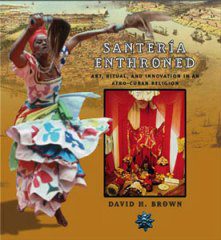 Santeria, also known as Regla de Ochá or Lucumi, is a religion that developed in Cuba from the beliefs of Yoruba religion brought to the New World by enslaved Yoruba people. They used Roman Catholicism to shield and preserve their beliefs and traditions. Over time, customs merged and Santeria is often thought of as a syncretic religion. It is hard to tell where the African and Catholic elements begin and end. In Santeria Enthroned: Art, Ritual, and Innovation in an Afro-Cuban Religion, David H. Brown explores the history of Santeria’s development.
Santeria, also known as Regla de Ochá or Lucumi, is a religion that developed in Cuba from the beliefs of Yoruba religion brought to the New World by enslaved Yoruba people. They used Roman Catholicism to shield and preserve their beliefs and traditions. Over time, customs merged and Santeria is often thought of as a syncretic religion. It is hard to tell where the African and Catholic elements begin and end. In Santeria Enthroned: Art, Ritual, and Innovation in an Afro-Cuban Religion, David H. Brown explores the history of Santeria’s development.
Combining art history, cultural anthropology, and ethnohistory, Brown focuses on the culmination of the religion, the initiatory throne. He concludes that Santeria today is the result of hard-won struggles, not passive survivals, and its resiliency is largely owed as much to innovative transformations in the New World as attempted preservation of African traditions.
Brown begins in the late 1500s, during Cuba’s colonial period, with the birth of cabildos, African ethnic associations based on Spanish fraternities that had the tutelage of a Catholic saint. These became bridges to house-temples. He highlights various branches, its founding figures, and ritual descendants. He looks at how these people negotiated competing ideologies to shape Santeria’s symbols, rituals, and institutions. He brings us to the present and into the United States to address contemporary ritual and iconography.
Brown’s is not a how-to-guide to Santeria. Santeria Enthroned is an academic study that assumes some knowledge on behalf of the reader. I highly recommend it for anyone seeking to learn more about Santeria’s historical development.
